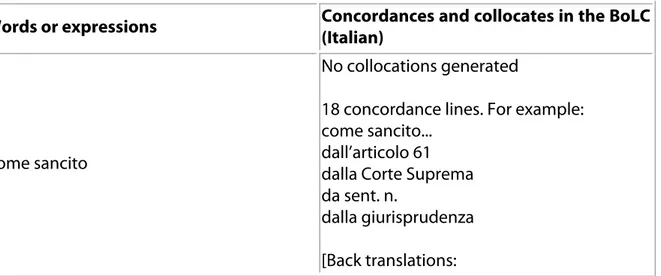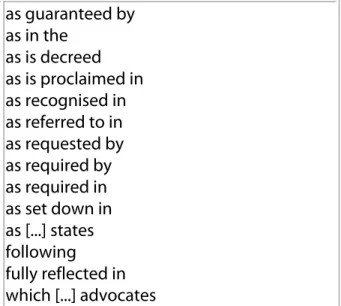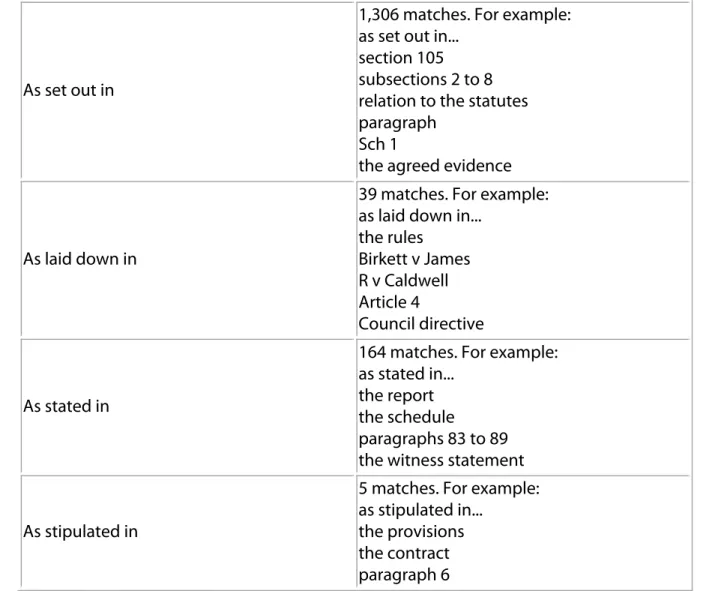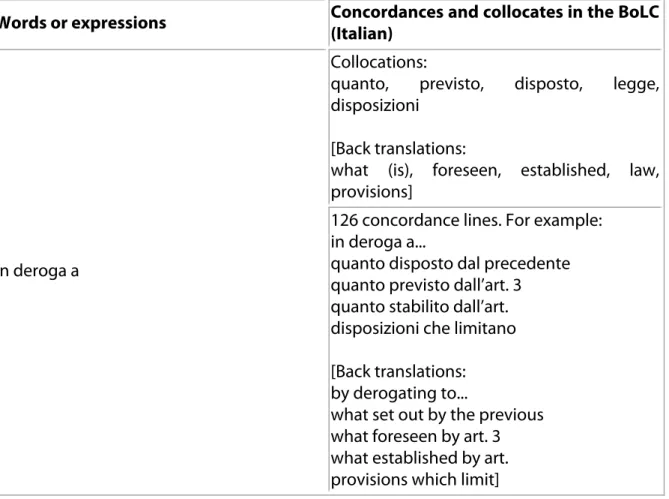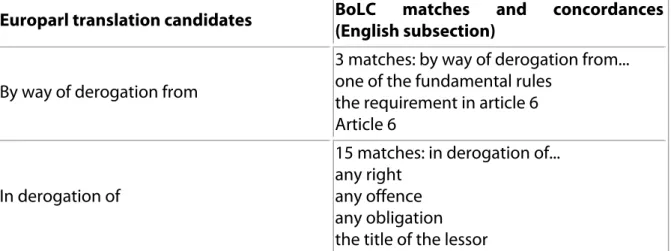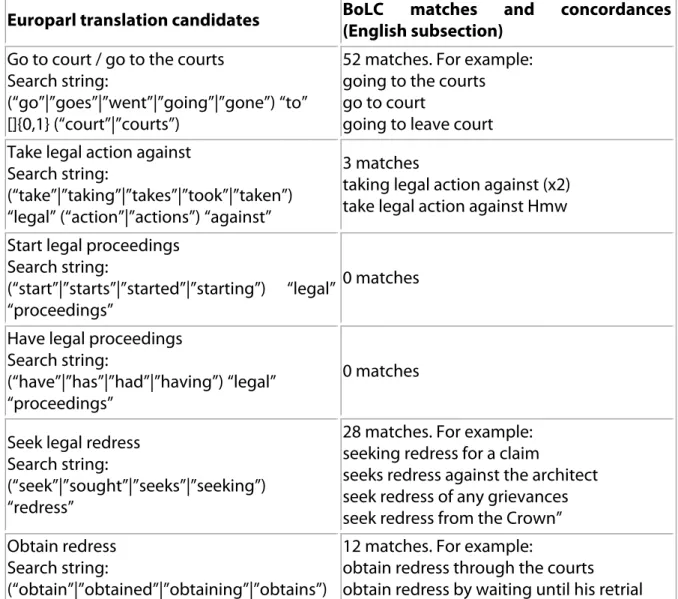Online Parallel and Comparable Corpora
for Legal Translations
byPatrizia Giampieri
ABSTRACT: The use of corpus linguistics for technical translations has largely been advocated by scholars over the years. This paper is aimed at providing instances of legal term search in online parallel and comparable corpora. In particular, it will highlight that they can be used jointly in order to deliver accurate legal translations and dispel linguistic doubts. To this aim, Italian legal lexical phrases and formulaic expressions will be searched in the Italian section of the Bononia Legal Corpus (the BoLC). Then, the translation equivalents of the lexical phrases will be searched in the European Parliament Proceedings Parallel Corpus (the Europarl). Finally, the proposed equivalents will be queried in the English section of the BoLC, where they will be analysed, together with their collocations and concordance lines. The findings of this paper will highlight that online parallel and comparable corpora can be considered reliable legal translation tools, especially if used jointly.
KEY WORDS: online parallel corpora; legal comparable corpora; legal translations; computational linguistics for technical translations
INTRODUCTION
The effectiveness of corpora for legal translations has long been argued by literature (Varantola 2002; Pastor and Alcina 2009; Zanettin 2012; Vigier and Sánchez 2017). In particular, the use of parallel and comparable corpora has been increasingly advocated in technical translations. Although scholars report that their differences are not clear-cut (Fantinuoli and Zanettin 2015: 3-4), parallel corpora are generally composed of source texts with their related translations. On the contrary, comparable corpora are composed of original texts in different languages, dealing with the same topic (Zanettin 2012: 11; Gatto 2014: 16). Many scholars highlight the importance of parallel corpora in order to deliver accurate translations and overcome the difficulties of technical texts (Teubert 2002; Zanettin 2002; Monzó Nebot 2008; Rura, Vandeweghe and Montero Perez 2008; Fantinuoli and Zanettin 2015). For example, it is reported that parallel corpora help translators cope with time constraints (Rura, Vandeweghe and Montero Perez 2008: 1). Translators, in fact, spend most of their time in consulting materials (Aston 1999). As dictionaries and the Internet are not always reliable (ibid.; Zanettin 2002: 11; Milizia 2010: 467), parallel corpora can help translators be more accurate by providing evidence of acceptable translation candidates. Parallel corpora, in fact, offer a quick overview of the translation solutions found by other translators confronted with similar equivalence challenges (Zanettin 2002: 11; Milizia 2010: 467). Another advantage of parallel corpora lies in the fact that they help enhance translation skills, as the translation candidates proposed can be interpreted and further analysed by the user (Bernardini 2011: 12; Vigier and Sánchez 2017: 273).
Comparable corpora are also reported to be particularly useful, as they help notice target language conventions (Biel 2010: 13). For these reasons, some scholars also suggest using parallel and comparable corpora together when dealing with technical translations (Bernardini 2011: 12).
Therefore, the aim of this paper is to shed light on the use of parallel and comparable corpora in order to translate legal texts. Legal jargon, in fact, is highly technical and specialised (Biel 2010). Furthermore, it is rather conventional and defined as “formulaic and somewhat abstruse” (Milizia 2010: 467). As a matter of fact, it is hallmarked by complex phrase structures (Coulthard and Johnson 2010: 10ff); archaic anaphoric and cataphoric adverbs (such as “thereinbefore”, Abate 1998: 14-16); high lexical density (Coulthard and Johnson 2007: 44); syntactic discontinuity (due to long sentences with coordination and subordination, Williams 2004: 113), and intricate formulaic expressions (such as “Know all men by these presents”, or “Give, devise and bequeath”, Bhatia 2010: 29). These characteristics make it particularly difficult and far from everyday language. For these reasons, comparable corpora (i.e., corpora composed of “original” texts) are particularly useful, because they provide instances of attested
usage in native-speaking contexts. On the other hand, parallel corpora can help translators find translation candidates on the basis of past translators’ choices.
In addition, legal discourse is characterised by other challenges, which are due to the differences in the source and target legal systems. Therefore, not only is linguistic expertise necessary to perform legal translations, but also legal knowledge plays a key role (Bhatia 1997: 209; Orozco-Jutorán and Sánchez-Gijón 2011: 25).
THE CORPORA
In light of the above, this paper is aimed at exploring whether the European Parliament Proceedings Parallel Corpus (the Europarl) (Koehn 2005; Tiedemann 2012) and the Bononia Legal Corpus (the BoLC) (Rossini Favretti, Tamburini and Martelli 2007) can be used to tackle legal translations. The Europarl (version 7) is composed of European Parliament proceedings and contains more than 60 million words per language. The Europarl is a vast parallel corpus, which is based on source texts and their translations into EU languages. In this respect, it is important to remark that concepts such as “source text” and “target text” become irrelevant in this corpus (Koskinen 2000: 55). The texts which compose it, in fact, can all be considered original texts, especially from a legal point of view (Fantinuoli and Zanettin 2015: 4). The BoLC, instead, is divided into two subsections: English (74 million tokens) and Italian (65 million tokens). The two subsections are comparable, as they autonomously address the same legal topics (acts of parliament, decrees, judgements in criminal/civil cases, etc.). The Europarl and the BoLC might seem unrelated, as the one deals with European Parliament proceedings and the other with documents of British legislative and administrative nature. Nonetheless, they can be used jointly, especially in settings where English is a global language. As a matter of fact, given the preponderance of English as a lingua franca in international contexts (Jacometti e Pozzo 2018: 54-58; 75; 189-190), they are very useful to dispel linguistic doubts.
This paper will argue that relying on one tool only cannot always be risk-free. Some translated texts composing the Europarl, for example, are often untrustworthy. Literature reports instances of ineffective renderings due to several reasons, such as flaws and inaccurate translations (Wagner 2010; European Commission 2012; Giampieri 2016); linguistic impreciseness of the EU drafters (Jacometti e Pozzo 2018: 169), or discrepancies due to the fact that the EU law is not anchored to a particular legal system (ibid.). Nonetheless, as stated above, comparable and parallel corpora can be very useful in technical translations, as they help find acceptable translation candidates, especially in contexts where English is a lingua franca (ibid.). Parallel corpora, in fact, provide instances of past translation choices, whereas comparable corpora provide examples of “real” attested usage. Therefore, this paper will explore whether the Italian and English subsections of the BoLC and the Europarl can be used as joint translation tools (Bernardini 2011: 12). In this respect, it will show that the shortcomings of the one can be
compensated for by the other. In practice, it will shed light on how to use both the Europarl and the BoLC effectively and successfully.
ANALYSIS
As outlined above, the Europarl and the BoLC will be used in order to tackle legal translations. To this aim, the translation candidates of the following Italian phrases and expressions will be searched: “come sancito” in phrases such as “come sancito dall’articolo 4” (literally “as sanctioned by article 4”); “in deroga a” in phrases such as “in deroga all’articolo 4” (literally “in derogation to article 4”) and “adire le vie legali” (literally “to take legal ways”). As can be seen, all expressions are remarkably formulaic and are highly recurrent in documents of legal and administrative nature (Bhatia 2010: 26-29).
Firstly, the phrases will be searched in the Italian subsection of the BoLC, where collocations and concordance lines will be analysed. Collocations are “patterns of habitual co-occurrence of a word with other word forms” (Gatto 2014: 30), whereas concordance lines are strings, or lines, of text containing the searched word, arranged so that they can be easily read (ibid.: 9). The expressions will then be searched in the Europarl in order to find translation candidates. Finally, the translation candidates will be queried and analysed in the English section of the BoLC, in order to count their occurrences, analyse their use in context, guess their exact meaning and verify whether they are consistent with the original expressions. In this way, it will be possible to explore to what extent the legal expressions of a lingua franca are similar to native equivalents.
The first term to be analysed is “come sancito”. Firstly, it will be searched in the Italian subsection of the BoLC (Table 1), then translation candidates will be searched in the Europarl (Table 2). Finally, the translation candidates will be assessed in the English subsection of the BoLC (Table 3).
Table 1 here below highlights the matches of “come sancito” in the BoLC Italian subcorpus.
Words or expressions Concordances and collocates in the BoLC (Italian)
Come sancito
No collocations generated
18 concordance lines. For example: come sancito...
dall’articolo 61 dalla Corte Suprema da sent. n.
dalla giurisprudenza [Back translations:
as sanctioned... by article 61
by the Supreme Court by judgement n. by case law]
Table 1. Analysis of concordances and collocates of “come sancito” in the BoLC Italian subcorpus.
As can be noticed, there are no collocations. This is probably due to the low number of matches (i.e., 18). Table 1 also highlights that “come sancito” is followed by the words “article”, “judgement” or by a law body (“Supreme Court” and “case law”).
Table 2 explores the translation candidates of “come sancito” in the Europarl.
Words or expressions (source language) Europarl translation candidates
Come sancito 108 matches: as enshrined in (x20) as set out in (x15) as laid down in (x10) as stated in (x9) as stipulated in (x5)
as [...] says / the [...] says (x4) as prescribed by (x3)
in line with (x3) pursuant to (x3)
under (the terms of) (x3) as established in (x2) as provided for in (x2) as sanctioned in (x2) in accordance with (x2) omission (x2) according to arising from as [...] allows as declared in as defined in as described as embodied in as endorsed at as envisaged in
as guaranteed by as in the as is decreed as is proclaimed in as recognised in as referred to in as requested by as required by as required in as set down in as [...] states following fully reflected in which [...] advocates
Table 2. Europarl translation candidates of “come sancito”.
One might argue whether the legal jargon is characterised by a wide spectrum of near synonyms, which would justify such a long list of translation candidates. As can be easily noticed, in fact, 37 translation varieties are used to render the Italian “come sancito”. Actually, scholars claim that legal discourse is generally highly formulaic and conservative (Bhatia, Langton and Lung 2004: 207). Therefore, the acceptable translation candidates of “come sancito” should be but a few.
In addition, some expressions reported in Table 2 are rather debatable because they are too general and pertaining to everyday language, such as “as [subject] says” or “the [subject] says”, which are used 4 times in the corpus; “as in the”, “following” and “which [subject] advocates”, each of which occurs once. The expression “as set down in”, instead, is semantically challenging.
It is now useful to explore which translation candidates are found in the English subsection of the BoLC. Table 3 highlights some interesting results concerning the most recurrent translation candidates found in the Europarl. In particular, it shows whether Europarl translation candidates can be retrieved in the English section of the BoLC, and, if so, it highlights their use in context.
Europarl translation candidates BoLC matches and concordances (English subsection)
As enshrined in
8 matches. For example: as enshrined in...
the Act
the guidelines the law of the land the Charter of
As set out in
1,306 matches. For example: as set out in...
section 105 subsections 2 to 8 relation to the statutes paragraph
Sch 1
the agreed evidence
As laid down in
39 matches. For example: as laid down in...
the rules Birkett v James R v Caldwell Article 4 Council directive As stated in
164 matches. For example: as stated in...
the report the schedule
paragraphs 83 to 89 the witness statement
As stipulated in
5 matches. For example: as stipulated in...
the provisions the contract paragraph 6
Table 3. BoLC matches and concordances of Europarl translation candidates.
First of all, despite topping the Europarl list, the phrase “as enshrined in” is not the most used term in the English subsection of the BoLC (8 matches). “As set out in”, instead, proves to be the most recurrent (1,306 matches), although more refined research would be called for in order to filter out phrases such as “as set out in relation to” (see Table 3 above). Nonetheless, “as set out in” is followed by words such as “section” (which is a synonym of “article”), which was noticed in the Italian subcorpus (Table 1).
The translation candidate “as stated in” (164 matches) is also satisfactory. However, the most suitable translation candidate is undoubtedly “as laid down in” (39 matches). As a matter of fact, not only does this formulaic expression collocate with rules and articles, but also with case law matters (e.g., “Birkett v James”). This corresponds to the use in context of the original expression “come sancito” (Table 1).
In light of the above, it can be stated that the translation candidates retrieved by using the Europarl corpus are generally reliable, although they can be slightly at odds with BoLC findings.
Another example will revolve around the translation of “in deroga a”. Table 4 will provide an analysis of the concordance lines and collocations of this phrase in the BoLC Italian subcorpus. Then, Table 5 will list the translation candidates found in the Europarl. Finally, Table 6 will highlight whether the translation candidates can be found in the BoLC English subcorpus and it will show their use in context.
Words or expressions Concordances and collocates in the BoLC (Italian)
In deroga a
Collocations:
quanto, previsto, disposto, legge, disposizioni
[Back translations:
what (is), foreseen, established, law, provisions]
126 concordance lines. For example: in deroga a...
quanto disposto dal precedente quanto previsto dall’art. 3 quanto stabilito dall’art. disposizioni che limitano [Back translations:
by derogating to...
what set out by the previous what foreseen by art. 3 what established by art. provisions which limit]
Table 4. Analysis of concordances and collocates of “in deroga a” in the BoLC Italian subcorpus.
It is self-evident that “in deroga a” collocates with verbs in the past participle form whose meaning is “established”, and with words such as “articles” and “provisions”.
Words or expressions (source language) Europarl translation candidates
In deroga a
6 matches: contrary to
by way of derogation from despite the
in derogation of omission
unrelated or non-aligned (“a system of exemptions”)
Table 5. Europarl translation candidates of “in deroga a”.
Table 5 above highlights debatable translations, such as “despite the” and “contrary to”, which seem pertaining to everyday language. Therefore, only the two remaining translation candidates will be searched in the English subsection of the BoLC (Table 6).
Europarl translation candidates BoLC matches and concordances (English subsection)
By way of derogation from
3 matches: by way of derogation from... one of the fundamental rules
the requirement in article 6 Article 6
In derogation of
15 matches: in derogation of... any right
any offence any obligation the title of the lessor
Table 6. BoLC matches and concordances of Europarl translation candidates.
By analysing Table 6 above, it can be noticed that although more frequent, “in derogation of” is not the best translation candidate of “in deroga a” in a phrase such as “in deroga all’articolo 4”. “In derogation of”, in fact, encompasses wider scopes (“any right”, “any offence”...). Therefore, “by way of derogation from” can be considered the best candidate. As a matter of fact, it collocates with words such as “article” and “the requirement in article” (a synonym of “provision”), which were noticed in the Italian subcorpus (Table 4). This example proves that, if used jointly, the Europarl and the BoLC provide reliable translation candidates.
The last phrase which will be analysed is “adire le vie legali”. Table 7 will highlight the collocations and concordance lines retrieved in the BoLC Italian subcorpus. Then, Table 8 will show the search results of the translation candidates in the Europarl, whereas Table 9 will verify whether the translation candidates are actually used in the English subsection of the BoLC.
Words or expressions Concordances and collocates in the BoLC (Italian)
Adire le vie legali No collocations found
searched through the string:
(“adire”|”adirà”|”adiranno”|”adito”) “le” “vie” ”legali”
la lavoratrice che voglia adire le vie legali dovrà
adire le vie legali e partecipare a [Back Translations:
the worker who wishes to take legal ways shall
take legal ways and participate in]
Table 7. Analysis of concordances and collocates of “adire le vie legali” in the BoLC Italian subcorpus.
As can be noticed in Table 7 above, the verb “adire” is considered a lemma. Therefore, the infinitive, future and past participle forms were searched. Nonetheless, the search only retrieved 2 concordance lines.
Words or expressions (source language) Europarl translation candidates
Adire le vie legali
39 matches:
go to court / go to the courts (x6) take legal action (against) (x6) start/have legal proceedings (x3) seek redress / obtain legal redress (x2) take (someone/this matter) to court / to the courts (x2)
(a) recourse to the courts (before) litigation
bring action against bring claims
bring legal appeals challenge (a refusal) court action
deal with the matter through legal channels haul someone before the courts
have legal recourse
make use of any legal means mount legal challenges omission
present (criminal) cases prosecute
pursue justice question the justice resort to law
seek legal remedy
intervention
Table 8. Europarl translation candidates of “adire le vie legali”.
As for the previous case, the translation candidate number is extremely high (24 varieties). Furthermore, some translation candidates are debatable, such as “present cases”; “question the justice”, “challenge” and “deal with the matter through legal channels”. These terms seem too general and not strictly pertaining to the legal jargon. Therefore, only the most recurrent renderings will be searched in the BoLC, together with two random phrases: “bring action against” and “bring claims”.
In order to make the BoLC search as comprehensive as possible, verb forms will be considered. Therefore, the phrase “go to court”, for example, will be searched by writing the following string: (“go”|”goes”|”went”|”going”|”gone”) “to” []{0,1} (“court”|”courts”). In this way, the system will consider "go" as a lemma. Table 9 reports the findings.
Europarl translation candidates BoLC matches and concordances (English subsection)
Go to court / go to the courts Search string:
(“go”|”goes”|”went”|”going”|”gone”) “to” []{0,1} (“court”|”courts”)
52 matches. For example: going to the courts go to court
going to leave court Take legal action against
Search string:
(“take”|”taking”|”takes”|”took”|”taken”) “legal” (“action”|”actions”) “against”
3 matches
taking legal action against (x2) take legal action against Hmw Start legal proceedings
Search string:
(“start”|”starts”|”started”|”starting”) “legal” “proceedings”
0 matches
Have legal proceedings Search string:
(“have”|”has”|”had”|”having”) “legal” “proceedings”
0 matches
Seek legal redress Search string:
(“seek”|”sought”|”seeks”|”seeking”) “redress”
28 matches. For example: seeking redress for a claim
seeks redress against the architect seek redress of any grievances seek redress from the Crown” Obtain redress
Search string:
(“obtain”|”obtained”|”obtaining”|”obtains”)
12 matches. For example:
obtain redress through the courts obtain redress by waiting until his retrial
“redress” her attempts to obtain redress have been thwarted
obtaining redress Take (someone/this matter) to court/the
courts
Search string:
(“take”|”takes”|”took”|”taking” |”taken”) []{0,7} “to” []{0,1} (“court”|”courts”)
21 matches. For example: take back to court
take the case to court
taking the Home Secretary to court took action. He applied to the court Bring action against
Search string:
(“bring”|”brings”|”brought”|”bringing”) [] “action” “against”
51 matches. For example: bring an action against another
brought an action against the defendant bring action against our client
Bring claims Search string:
(“bring”|”bringing”|”brought”|”brings”) [] “claims”
15 matches. For example: the bringing of claims against bring their claims in the High Courts bringing potential claims to court
Table 9. BoLC matches and concordances of Europarl translation candidates.
Table 9 provides information on the most recurrent Europarl translation candidates and on two other candidates. For example, it highlights that “go to court” is the most recurrent verb phrase in the BoLC, although more refined research should be carried out to filter out phrases such as “going to leave court”. “Seek legal redress” and “take to court” are also fairly widely used, although the objects “someone” and “this matter” of the latter (as suggested by the Europarl) are not present in the BoLC. As far as “obtain redress” is concerned, the BoLC shows instances where this phrase means “obtaining justice”, rather than “going to court” (e.g., “obtain redress by waiting until his retrial”). Furthermore, some searches provide no matches, as in the case of “start/have legal proceedings”.
It is also noticeable that the two phrases chosen randomly (“bring action against” and “bring claims”) provide some matches (51 and 15, respectively). For example, the BoLC shows that “bring action against” is very common, although it is almost neglected in the Europarl (1 instance, see Table 8).
Therefore, in light of Tables 7-9 above, it can be claimed that “adire le vie legali” can be translated either as “go to court” (corroborated by both the Europarl and the BoLC) or as “bring action against” (corroborated by the BoLC).
The examples reported above confirm that online legal parallel and comparable corpora can be used jointly in order to dispel linguistic doubts in legal translations. Although literature reports instances of how parallel corpora can be useful for legal translations (Milizia 2010; Vigier and Sánchez 2017), this analysis highlights that sometimes online parallel corpora, such as the Europarl, cannot be completely reliable. When this happens, comparable corpora can compensate for their shortcomings, as they
provide evidence of attested usage of legal terms in native speaking countries.
CONCLUSIONS
Parallel and comparable corpora are claimed to be important for technical translations (Teubert 2002; Zanettin 2002; Monzó Nebot 2008; Rura, Vandeweghe and Montero Perez 2008; Biel 2010; Fantinuoli and Zanettin 2015). In particular, they are very useful for legal translations because legal discourse tends to be highly formulaic and conventional (Bhatia, Langton and Lung 2004; Milizia 2010). However, the accuracy and reliability of some online parallel corpora are often debatable (Wagner 2010; European Commission 2012; Giampieri 2016). For this reason, this paper was aimed at verifying whether the European Parliament Proceedings Parallel Corpus (the Europarl) (Koehn 2005; Tiedemann 2012) and the Bononia Legal Corpus (the BoLC) (Rossini Favretti, Tamburini and Martelli 2007) could be used jointly in order to dispel doubts and deliver satisfactory legal translations, especially in settings where English is a lingua franca. On the one hand, in fact, the Europarl provides legal English translation candidates of some Italian formulaic expressions and lexical phrases. On the other hand, the English section of the BoLC can either corroborate or confute the candidates proposed by the Europarl.
In particular, the analysis brought to the fore some shortcomings. In the translation of “in deroga a”, for example, the Europarl provided a few translation candidates, one of which was unrelated and two of which were unspecific, or pertaining to everyday language (“contrary to” and “despite the”). Other instances of lack of specificity of the Europarl translation candidates were the phrases “as [subject] says” or “following”, which were supposed to translate “come sancito”. What was also peculiar about “come sancito” was the fact that the best translation candidate proposed by the Europarl (i.e., “as enshrined in”) was not the most recurrent in the BoLC. In this respect, in fact, an analysis of the translation candidates in the English subsection of the BoLC highlighted that this formulaic expression was best rendered by “as laid down in”. This was corroborated by analysing the words in context in the corresponding Italian subsection. Furthermore, the number and type of translation candidates proposed by the Europarl were far too various (37 varieties). This was at odds with scholars’ findings, reporting that legal discourse is highly formulaic and conventional (Bhatia, Langton and Lung 2004; Milizia 2010). In these cases, the BoLC helped compensate for these shortcomings. Translation candidates, in fact, were searched in the English subsection, where it was possible to verify the number of occurrences, understand the use in context, infer the “real” meaning of each candidate and eschew unfit translation candidates. Another interesting example was the formulaic expression “adire le vie legali”. As in the previous case, the Europarl provided a wide number of translation candidates (24 varieties). These, however, were narrowed down to just a few after a search in the English subsection of the BoLC. For example, the most recurrent Europarl expression (“go to court”) was corroborated by the BoLC. Other expressions, instead, (such as “start/have legal proceedings”) were unmatched in the BoLC. On the contrary, the verb phrase “bring
action against”, which was almost neglected in the Europarl (1 occurrence only), showed a high recurrence in the BoLC (namely, 51 matches).
In light of the analysis carried out in this paper, it can be asserted that online comparable and parallel corpora can be (or should be) used jointly in order to deliver satisfactory legal translations.
WORKS CITED
Abate S.C., 1998, Il documento legale anglosassone, Hoepli, Milano.
Aston G., 1999, “Corpus use and learning to translate”, Textus 12, 289-314, <http://www.sslmit.unibo.it/~guy/textus.htm> (30 May 2018).
Bernardini S., 2011, “Monolingual comparable corpora and parallel corpora in the search for features of translated language”, SYNAPS – A Journal of Professional
Communication 26, pp. 2-13, <https://brage.bibsys.no/xmlui/bitstream/handle/
11250/2393975/Bernadini_26.pdf?sequence=1> (30 May 2018).
Bhatia K.L., 2010. Textbook on Legal Language and Legal Writing, Universal Law Publishing Co. Pvt. Ltd, New Delhi.
Bhatia V.K., 1997, “Translating Legal Genres”, in Trosborg A., Text Typology and
Translation, John Benjamins Publishing, Amsterdam/Philadelphia, pp. 203-214.
Bhatia V.K., Langton N.M. and Lung J., 2004, “Legal discourse: Opportunities and threats for corpus linguistics”, in Connor U. and Upton T.A. (eds.), Discourse in the
Professions. Perspectives from Corpus Linguistics, John Benjamins,
Amsterdam/Philadelphia, pp. 203-231.
Biel Ł., 2010, “Corpus-Based Studies of Legal Language for Translation Purposes: Methodological and Practical Potential”, in Heine C. and Engberg J. (eds.),
Reconceptualizing LSP. Online proceedings of the XVII European LSP Symposium 2009,
Aarhus University, Aarhus, <http://bcom.au.dk/fileadmin/www.asb.dk/isek/biel.pdf> (30 May 2018).
Bononia Legal Corpus, <http://corpora.dslo.unibo.it/BOLCCorpQuery.html> (25 September 2018).
Coulthard M. and Johnson A., 2007, An Introduction to Forensic Linguistics. Language
in Evidence, Routledge, London/New York.
Coulthard M. and Johnson A. (eds.), 2010, The Routledge Handbook of Forensic
Linguistics, Routledge, Abingdon.
Europarl V7, <http://opus.lingfil.uu.se/> (30 May 2018).
European Commission, 2012, Studies on translation and multilingualism. Quantifying
Quality Costs and the Cost of Poor Quality in Translation, Publications Office of the
European Union, Luxembourg, <https://publications.europa.eu/en/publication-detail/-/publication/d7c7f89c-3235-4b54-bab9-810802ef4b1b/language-en> (30 May 2018).
Fantinuoli C. and Zanettin F., 2015, “Creating and using multilingual corpora in translation studies”, in Fantinuoli C. and Zanettin F. (eds.), New directions in corpus-based
Gatto M., 2014, Web as corpus: Theory and Practice, Bloomsbury, London.
Giampieri P., 2016, “A Critical Comparative Analysis of Online Tools for Legal Translations”, The Italian Law Journal 2(2), pp. 445-461.
Jacometti V. e Pozzo B., 2018, Traduttologia e linguaggio giuridico, Wolters Kluwer, Milano.
Koehn P., 2005, “Europarl: A Parallel Corpus for Statistical Machine Translation”, in
MT Summit X,
<http://homepages.inf.ed.ac.uk/pkoehn/publications/europarl-mtsummit05.pdf> (30 May 2018).
Koskinen K., 2000, “Institutional Illusions: Translating in the EU Commission”, The
Translator 6, pp. 49-65.
Milizia D., 2010, “A Linguistic Investigation of the Lisbon Treaty”, Studi
sull'integrazione europea 2, pp. 455-474.
Monzó Nebot E., 2008, “Corpus-based activities in legal translator training”, The
interpreter and translator trainer 2(2), pp. 221–252.
Orozco-Jutorán M. and Sánchez-Gijón P., 2011, “New Resources for Legal Translators”, Perspectives: Studies in Translatology. 19(1), pp. 25-44.
Pastor V. and Alcina A., 2009, “Search techniques in corpora for the training of translators”, in Ilisiei I., Pekar V. and Bernardini S. (eds.), Proceedings of the international
workshop on natural language processing methods and corpora in translation, lexicography,
and language learning, Incoma, Borovets, pp. 13-20,
<http://aclweb.org/anthology//W/W09/W09-42.pdf> (30 May 2018).
Rossini Favretti R., Tamburini F. and Martelli E., 2007, “Words from Bononia Legal Corpus”, in Teubert W. (ed.) Text Corpora and Multilingual Lexicography, John Benjamins, Amsterdam/Philadelphia, pp. 11-30.
Rura L., Vandeweghe W. and Montero Perez M., 2008, “Designing a parallel corpus as a multifunctional translator’s aid”, in Proceedings of the XVIII FIT World Congress, Foreign Language Press, Shanghai, <https://biblio.ugent.be/publication/712916> (30 May 2018).
Teubert W., 2002, “The role of parallel corpora in translation and multilingual lexicography”, in Altenberg B., Granger S. (eds.), Lexis in Contrast. Corpus-based
approaches, John Benjamins, Amsterdam/Philadelphia, pp. 189-214.
Tiedemann J., 2012, “Parallel Data, Tools and Interfaces in OPUS”, in Calzolari N. et al., Proceedings of the Eight International Conference on Language Resources and
Evaluation (LREC’2012), European Language Resources Association, Istanbul, pp.
2214-2218, <http://www.lrec-conf.org/proceedings/lrec2012/pdf/463_Paper.pdf> (30 May 2018).
Varantola K., 2002, “Disposable corpora as intelligent tools in translation", Cadernos
de Tradução IX – Tradução e Corpora. 1(9), pp. 171-189.
Vigier F.J. and Sánchez M., 2017, “Using Parallel Corpora to Study the Translation of Legal System-Bound Terms: The Case of Names of English and Spanish Courts”, in Mitkov R. (ed.), Computational and Corpus-Based Phraseology. Second International Conference,
Wagner E., 2010, “Why does the Commission need a Clear Writing campaign”, in Pereira, A. (coordinator), Languages and Translation: Clear Writing, European Commission Directorate-General for Translation, pp. 4-5.
Williams C., 2004, “Legal English and Plain Language: an introduction”, ESP Across
Cultures 1, pp. 111-124.
Zanettin F., 2002, “Corpora in translation practice”, in LREC Workshop on Language
Resources for Translation Work and Research, Third International Conference on Language
Resources and Evaluation, pp. 10-14, <http://www.lrec-conf.org/proceedings/ lrec2002/pdf/ws8.pdf> (30 May 2018).
Zanettin F., 2012, Translation-Driven Corpora: Corpus Resources for Descriptive and
Applied Translation Studies, Routledge, London.
_____________________________________
Patrizia Giampieri has got a Master of Science in Applied Linguistics (Aston University,
Birmingham, UK). She lectures English at the School of Law of the University of Camerino, Italy. She lectures legal English in courses for lawyers. She is the author of
Legal English (Milan, Giuffrè 2015 and 2017) and Inglese giuridico, Web e corpora (Legal English, Web and Corpora, Milan, Giuffrè 2018). She has also written and published articles
on legal English and legal translations.
